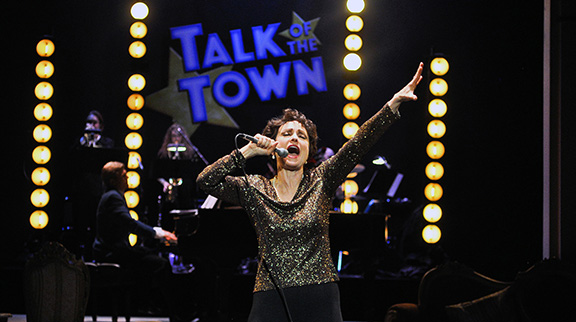A Review of End of the Rainbow, on stage at the Long Beach International City Theatre.
Set during Judy Garland’s attempted comeback at London’s Talk of the Town nightclub in 1969, Peter Quilter’s End of the Rainbow is, in duck terms, an odd mallard. The narrative orbits addiction, but never is allowed to dip into the bleak emotions delivered so devastatingly in other addiction narratives like, to pick one example, Darren Aranofsky’s Requiem for a Dream. Yet the livening banter, sarcastic more than sparkly, never sheds enough bitterness to allow the story to lift up. Whatever amusement there is – and what amusement can there be in watching someone disintegrate? – is bitter-comic. There are beloved Garland songs, of course, some delivered with straight-up showmanship, others served on the rocks to depict her declining performance ability. Is it our toes that we’re supposed to tap, or our tear-ducts?
Let’s not kid ourselves into thinking that the play offers us any new insight into a signature performer from Hollywood’s Golden Age. The tale of celebrity self-destruction is a familiar one, with Garland only one in a parade of stars who have been tragically felled by drug and alcohol addiction. While the cast is small, we find embodied in the characters of Anthony (the pianist, portrayed by music director Brent Schindele), and Mickey Deans (the fiancé, portrayed by Michael Rubenstone) the expected muddle of supporters and enablers, exploiters and would-be saviours. Gigi Bermingham is given the role of Garland, which she ably inhabits with pathos if not fireworks. We have seen all this before. Only the names have been changed to satisfy tabloid prurience.
As one expects from the reliable ICT, it’s all well done, with agreeable performances situated in a clever set whose pieces move to reveal or conceal the band for musical numbers. Yet all the ICT’s skill can’t infuse ambition into a play that ultimately comes to rest in an old straw mattress: The dying star redeemed and immortalized via classic recordings and, arguably worse, nostalgia. A provocative question might be: What about audience complicity in a performer’s self-immolation on the altar of popular adoration? The better question must certainly be: Is great art, whatever its form, worth the artist’s suffering? We can’t fault Quilter for writing Garland a tear-streaked love letter instead of a postmodern autopsy. But shouldn’t we be savvy enough to move past the symptoms into a more substantive study of the narcotic crucible that forges a person into an icon?
The trouble with End of the Rainbow is that, aside from a tilt towards the pitying, it can’t balance the romance of Judy Garland with her “reality,” thereby reducing the impact of both. Of course, the act of dealing with iconic figures comes with its own set of rug-pullers: Garland’s high wattage works against serving an undistilled black comedy, while her addictive descent invariably dims the stage lights. The lukewarm result is that the pot of gold intended for the end of the rainbow is instead a pot of bronze.
End of the Rainbow. Written by Peter Quilter. Directed by John Henry Davis. Musical Direction by Brent Schindele. On stage at the International City Theatre in Long Beach. Performances from February 18 to March 15, 2015. For information and tickets, visit www.internationalcitytheatre.org or call 562.436.4610.

